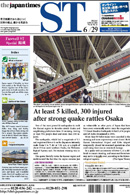Essay
The big one
I was in Japan for the March 11, 2011, earthquake and tsunami, and it was a frightening experience. But this was in Japan, with the most earthquake-resistant construction in the world.
Now I live in northern Washington state on the U.S. West Coast, and one major topic of conversation these days is when we will see the next big earthquake and tsunami (or "tidal wave," or "seismic sea wave," as some people still say). After all, the last big tsunami happened a long time ago, and we're about due for another one.
The last "big one" was the Cascadia earthquake and tsunami of 1700. Tectonic plates moved against each other off the Pacific Northwest coast and created a huge tsunami that — according to oral traditions of Native Americans and First Nations peoples in Canada — wiped out whole tribes.
The tsunami was so powerful it crossed the Pacific Ocean to hit Japan in the 12th year of the Genroku Era of the Edo Period, causing some flooding.
That was more than 300 years ago. The average time between earthquakes/tsunami can range from 243 to 400-500 years, so what if the next big one happened today? How prepared are places like California and British Columbia?
Woefully unprepared, according to seismologists.
In our small town, near one major supermarket, there is a sign pointing up a hill saying "Tsunami Evacuation Route." Thankfully our house here is on a hill, but internet information says to please help children under 5, the disabled and tourists. But one emergency specialist in Oregon says, "When that tsunami is coming, you run!"
We live in a tourist town, and the main street has a lot of shops and art galleries, right on the waters of Puget Sound. The local tsunami prevention site says that while only a small portion of the town is in the "inundation zone," 36 percent of the town's business is there! Most of the town is higher up on the bluff.
There are many military installations near our town, and in July there was a tsunami drill held between the U.S. Navy and the local fire department and other first responders. While it was a good start for coordinated activity, other information on the internet can be more frightening.
If there is a magnitude 8 or 9 earthquake and a tsunami near here, it will take one to three months to restore electricity, and a month for drinking water — the whole economy of the Pacific Northwest will collapse! If you've been to Seattle, you might know that 15 percent of the city is on reclaimed, liquefiable land. If the big one hits, then cars, buses and buildings could just sink into the ground. Fingers crossed I'm not here then!
次にやってくる津波と地震
筆者は東日本大震災が起きた時には日本在住だったが、現在は米西海岸のワシントン州で暮らしている。その地域の住民の間で最近よく話題になるのが、「次の大地震と津波はいつ起きるか」だ。
The Japan Times ST: November 4, 2016
The Japan Times ST 読者アンケート
この記事のご感想をお聞かせください。





